Dive Computer Infos for Freshman
Contents:
- Inner Life of a Dive Computer
- Basic Working Principle of a Dive Computer
- What kind of computers are there?
- Which table models are used?
- Dangers and Limitations!
back to: DIVE TABLES homepage
Inner Life of a Dive Computer
The basic components are:
- a housing, normally waterproof, pressure-resistant with a display. But that depends on the basic housing layout, pls. cf. below
- a printed circuit board with all the electronics
- the pressure sensor: either a piezo crystal or a capacitive resistance
- power supply
- Reed Relais or water-sensors: on/off switch and handling
- as well: a quartz crystal clock for the timing and the synchronisation of the electronic chips
As a matter of course the housing is waterproof. But normally these are not gas-proof! That is, during an excursion in a recompression chamber, put your computer in a water-filled bucket: otherwise the air is diffusing into the housing and upon ascent the box will crack due to the expanding air ...
The basic different housing designs are:
- Air filled, e.g.: COCHRAN
- Silicon Gel filled, e.g.: Suunto
- Oil filled, e.g.: Uwatec
This means, either the housing has to be sturdy and robust or the chips themselves ...
On the circuit board all the components are soldered according to the following principle:
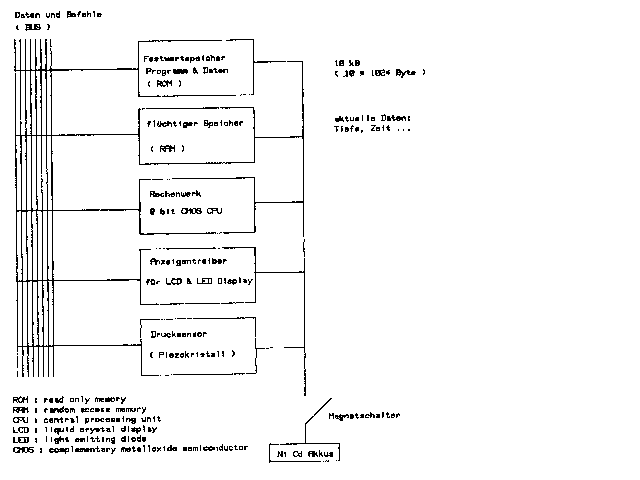
once upon a time, the interior of a good old DECO BRAIN looked like that:
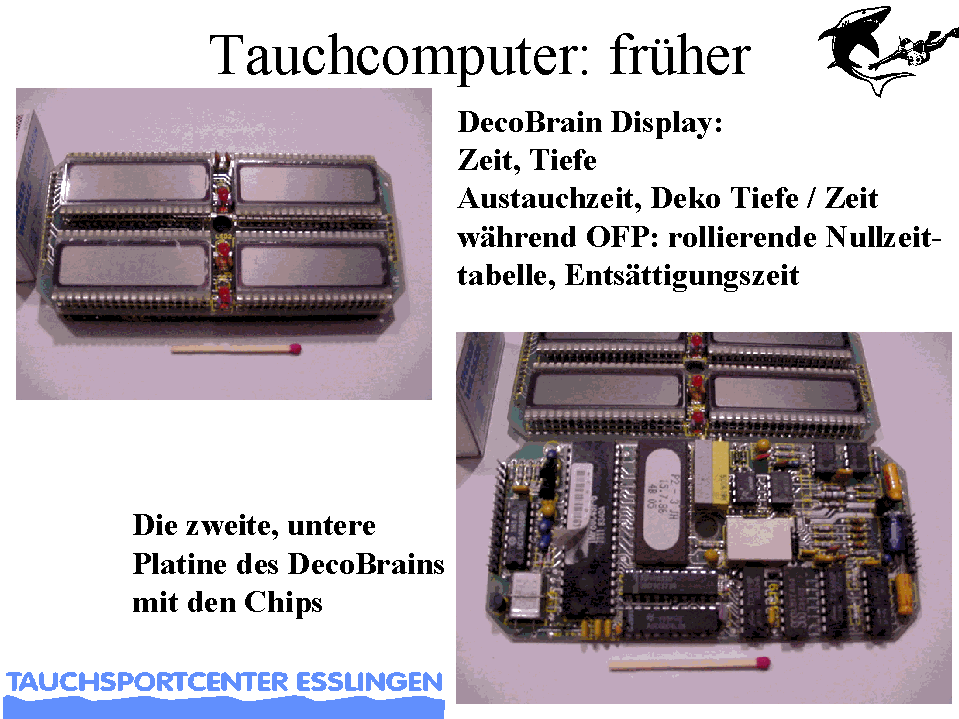
The small piezo crystal transforms the ambient pressure into a measurable voltage (Piezo Effect): with a small operation amplifier this voltage is measured and then the depth is calculated. It could be as well a capacitive resistance. All these things are temperature-dependant, so the whole set-up is temperature drift compensated ...
Now you see immediately, that the computer has to be salt- or fresh water calibrated in order to calculate
the correct depth. This is no safety concern:
the depth is just for your dive planning or logbook entry or so: the decompression calculation does not depend on the displayed depth but on the real, the measured pressure.
The power supplies are nowadays small Lithium-Ion batteries with a minor self-discharge coefficient so these things last for a couple of years. This was possible only with the modern chip design, which resulted in full custom ASIC chips with very low power consumption. The chips in the old Deco Brain used up power, oh boy, I can't tell (as well the Orca EDGE ..)
Normally, by switching off, you switch off just the display, the computer carries on calculating all the desaturation as well it checks the ambient pressure all the time. So it sees, if you are on the way to your favorite mountain-lake.
Quite a new model looks like that:
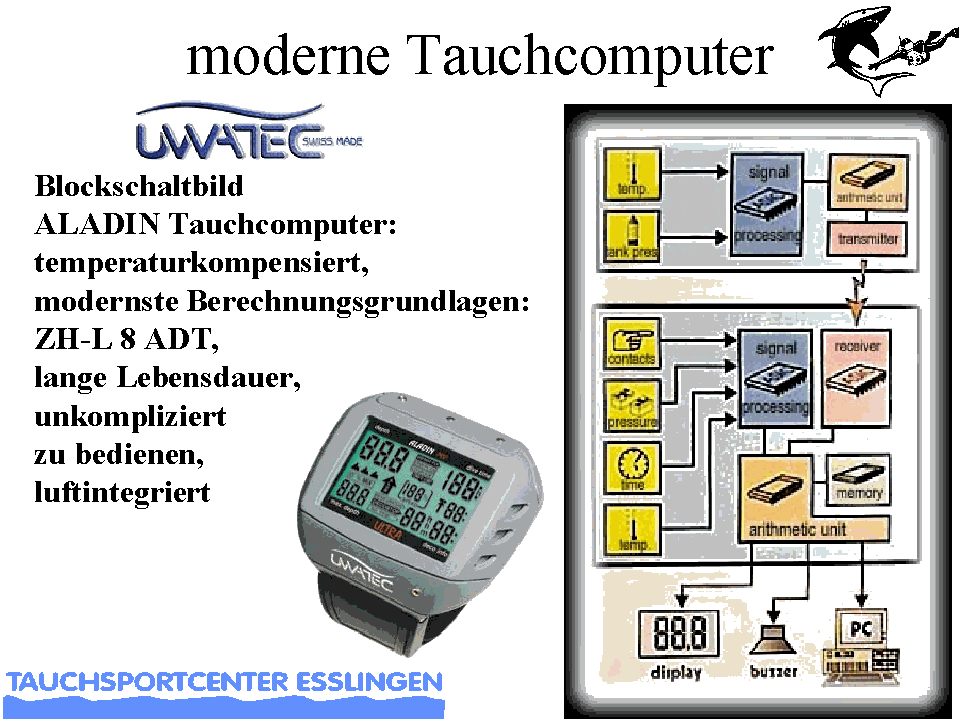
Basic Working Principle of a Dive Computer
The data from the quartzclock (= dive time) and from the piezosensor (pressure -> depth) are feed directly into the inertgasloading calculations for the various compartments (the notion "compartments" pls. cf. below). This is quite comparable to what you do with your dive table: with depth and dive-time you look up a certain repetitive/pressure group. The only difference is, that you do it once for a rectangular dive profile and the computer does this job normally every 2 seconds or so and calculates a "Multi Level Profile". This calculation is repeated for every compartment (normally a resonable dive computer has 9 or more compartments, 6 beeing the absolute minimum) and thus checks the remaining no-decompression time, or, in case of a deco-dive, the resulting deco-times on the various deco-depths. During the surface intervall the computer takes the desaturation into account and you could check this via a rolling NDL display, showing the adjusted NDLs for your repetitive dives from 9 to 42 m or so. Why are the adjusted NDLs shortened in comparison to your first dive? Well, from your first dive you have a certain amount of inertgasloading.
What are thus the practical consequences?
1. through the basic difference between a rectangular and a multilevel profile are the multilevel NDLs longer: normally you do not stay the complete bottom time on your planned table-depth, instead you dive increasingly shallower. With the desaturation through the ascent your dive computer will show you increasing NDLs by going up.
2. different dive computers differ by:
- number of compartments, and their:
- respective halftimes
- respective allowed critical or super-saturation
- the principal model, that is the basic algorithm for saturation/desaturation calculations
this implies regularly:
- the NDL for the first dive of the day differs, not by much,
say + / - 10 to 25 %. For e.g. the NDLs for 40 m are around 7 to 11 min.
- for repetitive dives and, in particular for dives with deco stops. Then the difference can be as great as 500 %: now the different models reveal their hidden agendas ... Another example you will find there. Why this? Have a look at the next but one chapter.
back to: Contents
What kind of computers are there?
We could differentiate between:
- the "normal, or regular" boxes, wrist or console worn, say without integrated pressure gauge
- with integrated pressure gauge, with or without hose (then the pressure-data is transmitted wireless) with or wo. air-consumption-calculation (i.e.: guesstimate ...)
- for AIR, NITROX or other mixed gases, say with Helium, allowing a reprogramming, even underwater, for 2 or more different mixes
- a multi-purpose unit, with all of the above, plus an interface for an oxygen sensor for operating a semi- (SCR) or fully-closed (CCR) circuit rebreather
Which one do you want? Well, have a look in your moneybag! And as well at your certifications ...
That is: for what kind of diving do you want this unit?
Damn sure you should visit a reasonably good dive shop with a profound guidance:
AND: you should have the opportunity to rent the box in question for a couple of days,
OR: to jump into the next pool ...
Which table models are used?
A couple of quick definitions of notions, which "surface" all along these discussions:
- Compartments: basically these are mathematical models for tissue groups in a body.
These compartments are designated with a certain halftime (=HT) in minutes.
So there are fast and slow compartments.
Slow compartments have a slow nitrogen (or inertgas) uptake and, vice-versa, also a slow
inertgas release. Examples could be: bones, cartilage, marrow.
Fast compartments handle the absorption and release of inertgases quicker. Examples: blood, muscles, and, maybe, your internal ear. - The mathematical description of this behaviour lays in the above mentioned HT:
a HT is just the time, a compartment uses to get saturated (or de-saturated) by 50 %. Such kind of things you know already: it is radioactivity or the cooling down of your hot coffee. It follows a so called exponential curve.In a simple scheme it looks like that:
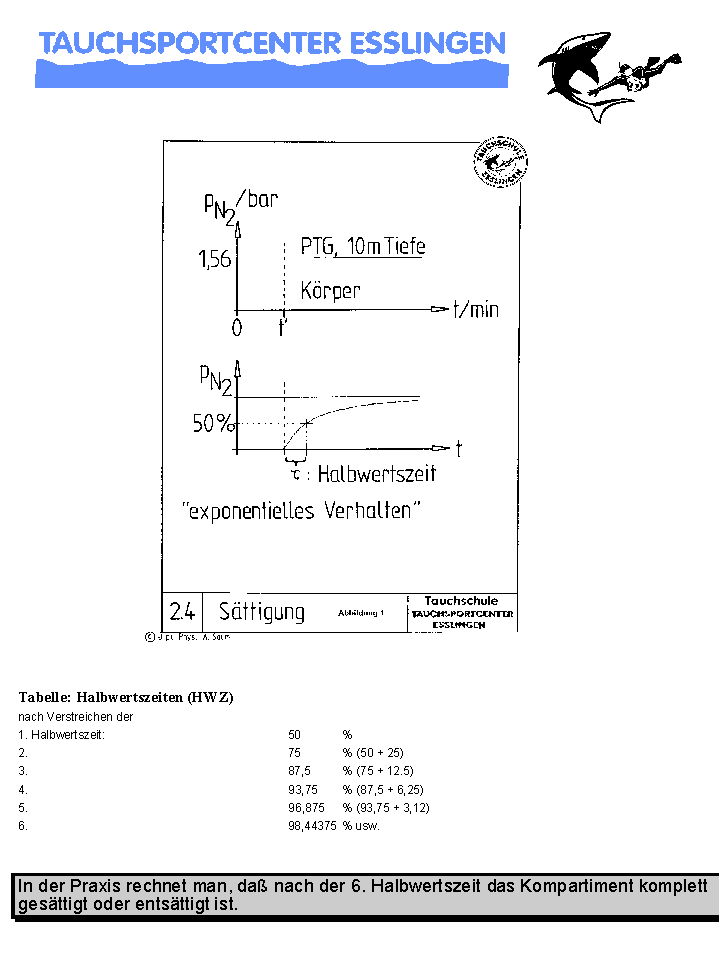
- Furthermore: the maximal allowed or tolerated ambient pressure. To put it in completely other words: the inertgasloading a compartment can withstand without the development of DCS symptoms. This is a supersaturation relative to the ambient pressure.
The mother of all dive tables is the model of Haldane. This clever guy, John Scott Haldane, lived from 1860 to 1936 in Scotland. He developped, together with 2 other good guys, Arthur E. Boycott and Guybon C. Damant, approx. 1907 for the British Royal Navy, the first dive table of the world with staged decompression! It was first published in 1908 officially with the goal, to make diving as safe as possible and decompression as short as needed by avoiding the, then-called "CAISSON" disease, vulgo Decompressionsickness, DCS.
The direct siblings are the U.S. Navy Tables from 1933 and 1957. And these in turn do have a direct child: the PADI / DSAT table, aka RDP (Recreational Dive Planner). This took place approx. 1988. The RDP No-Decompression-Limits (NDLs) are shorter and the complete nitrogen-clearance has been set to 6 h (instead of 12 h as with the USN table).
Quite a bunch of other models are based on the ideas of "Bühlmann-Hahn". Basically these are extensions of the old haldanean ideas to reduced ambient pressure (mountain-lake), the basic Schreiner equation ist still used in this "ZH-L 16" Algorithm. An algorithm is just a rule to do certain calculations. ZH-L 16 means: ZH like Zürich (Prof. Albert A. Bühlmann was Professor for internal medicine at the clinical center in Zürich, Switzerland and my late friend Dr. Max Hahn; he was physicist and CMAS Instructor), L like Linear, 16 is the amount of compartments. This model has been developped and tested very thoroughly in cooperation with Hannes Keller approx. 1960. Even with viewy self-experiments with HELIOX in depths up to 300 m! Later on the oil industries took interest in these things and supported these guys financially.
The grass roots have been the works of Robert D. Workman (1965: Nitrox and Heliox
Decompression, M Values, 9 Compartiments) and
Heinz R.Schreiner with already 15 compartments (1968) and the pioneering works of 2 german professors,
Siegfried Ruff and Karl Gerhard Mueller (1966). They racked their brains concerning bubble nucleation and calculations
and as well with saturation diving and Helium-Decompression. Also they wanted to make the decompression of mine workers more safely.
Now since approx. 1994 we find in the ALADIN computers the model ZH-L 8 ADT, ADT like adaptive for cold and air-consumption / exertion, with 8 compartments.
Since 2002 we find similar models, like the ZH-L 8 MB. The MB stands for micro bubbles. The box allows for micro bubble reduction through user-programmable deep stops, which are called there "level stops".
The least common denominator of all these models is:
the inertgas saturation / uptake (and: de-saturation / release) is an exponential process.
This saturation process during diving is in parallel within all the considered compartments,
during ascent and the SI the desaturation is as well a parallel process.
Thus these models are called "parallel" models.
Some other models differ as well in the desaturation calculation:
- this is sometimes done in a linear fashion
- and sometimes with just only one compartment, the so-called "leading tissue"
- this leading tissue or control compartment is for the USN 120 min, for the RDP 60 min.
There are some other models, just to name a few:
- serial models: all the compartments are combined in a serial manner, i.e. one after the other
e.g.: the DCIEM table combined 4 serial compartments (then the: Defence and Civil Institute of Environmental Medicine in Canada) from approx. 1987 and refined in 1992 - slab models: one compartment with a geometry like a sheave,
e.g.: the BSAC table, from the British Sub Aqua Club from 1988 - thermodynamic models
- statistical models like the: "Maximum Likelihood"
- VPM (= varying permeability model)
- RGBM (= reduced gradient bubble model)
The biggest part of all dive computers worldwide are useing, in one way or another, the ZH-L models due to the following facts:
- there is a complete and easily understandable documentation available:
- [4], [5] and [65] from this literature list
- so the results could be proofed by (nearly) everybody
- an especially ideal paradigm is the Deco Brain
- all the coefficients and the mental reservations have been documented in the excellent manuals
- (Rem.: as well the ORCA EDGE was outstanding for his clear documentation and description of the underlying model, in this case a modified M-Value approach, what we will find also in the Standard USN tables.)
- more infos you will find my little virtual divecomputer museum
- in particular you will find the ZH-L 16 parameters and as well Workmans M-values for Helium
- and the outcomes for thousands of extreme long and deep dives have been documented very painstaking!
- and this, especially in the domaine for commercial bounce- and saturation-dives!
- as well in extreme mountain-lakes like the Titicaca lake!
- Bottom Line: the statistical coverage for these types of models is very good!
- more infos, and the complete theory of decompression calculation
- Since approx. 2003 there are a couple of computers available, who run, at least on the papers, the RGBM models ...
- For good or ill these boxes have a so-called "RGBM folded over ZH-L"
- so they calculate internally with a standard ZH-L model, and only the 2 model parameters,
- the a- and b-coefficients are simply multiplied with the RGBM f-factors ...
very nice euphemistics for these things: "tiny RGBM, recreational RGBM, modified RGBM" ...
I like best the "Haldane imbedded", which describes exactly what these boxes are really doing ... - need in-depth infos? here we are: RGBM folded over ZHL ...
A more or less schematic overview for the compartments, their halftimes and their respective a- and b coefficients:
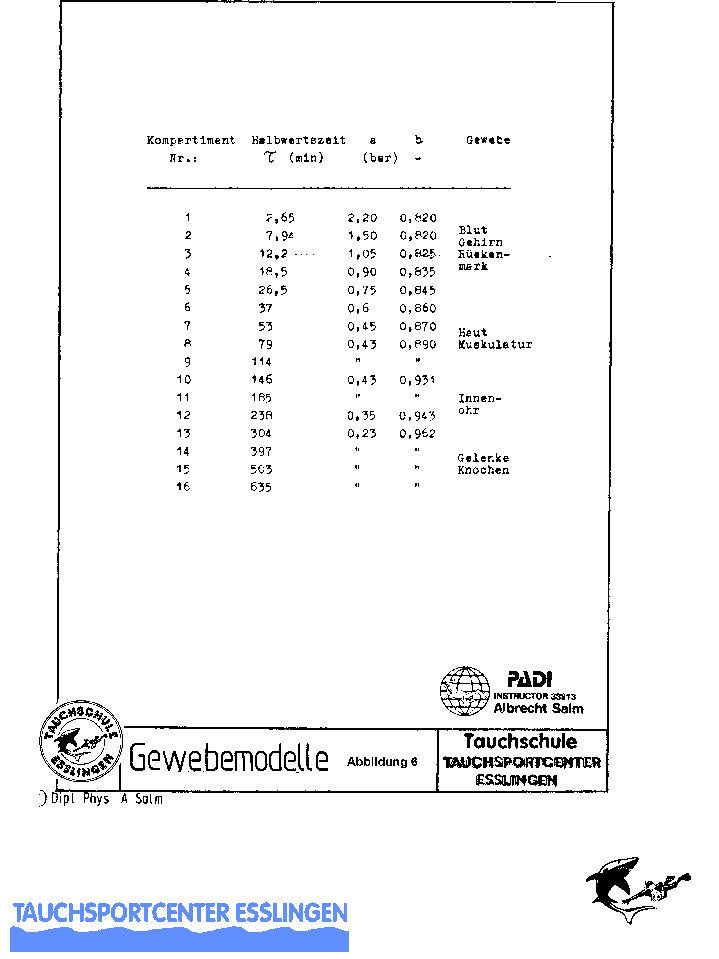
back to: Contents
Dangers and Limitations!
- CAUTION with alcohol, nicotine, medications!
- cold, exertion, insufficient fitness: increase the safety stops by a couple of minutes!
- as well with "reversed profiles", i.e.: first shallow, then deep: try to avoid this!
- no Jo-Jo dives (saw tooth profiles)!
- (Rem.: a standard dive computer can not handle this adequately, keyword: low pass!)
- with Non-Limit diving / diving safaris: try to refrain from diving for 24 h every 3 rd. to 4 th. day!
- Check your hydration status! Drink plenty of mineralwater! Avoid coffee, tea or fitness-drinks!
- No skip-breathing!
- Avoid stress, hectic, fear, peer pressure!
- Do not follow your dive-computer display slavishly! Do not jump immediately to the surface when you just recieved the clearance! Stay a couple of minutes longer in 3 to 5 m depth: watch the fish and the corals ...!
- or use the Ascent Pattern © ALBI
- more infos concerning decompression dives here
Why so? Very easy:
your dive computer does not have a clue about your hydration status, nor does
it know if you have a bad hang over!
As well it does not know if you took any medication, or if you stupidly smoked before the dive!
As well the box is ignorant if you felt cold during the safety stops or if you battled
against a current ...
All of the above may increase your susceptibility to DCS!
Everything pumping more inert gases into your body (cold, exertion) and everything
interfering with desaturation should thus be avoided:
Cold changes not only the perfusion of your skin and muscles, as well it increases
the solubility of inertgases (Henry's Law).
Skip breathing may increase your CO2 level and thus change the acid-base balance in your blood.
Lots of so called "undeserved DCS" i.e.: DCS despite correct dive table or dive computer handling and despite correct ascent procedures has been explained through insufficient fluid intake and / or dehydration through sweating, vomiting, squirts, dehumidified compressor air or alcohol abuse the day before.
So what is the practical consequence for the dive computer handling?
- you have to know your dive computer manual and all the displays by heart (even when in narcosis ...), you should run the machine in all the modi blindfolded ...
- before leaving the surface, check if the box runs properly: self test o.k.? batteries full? Display intelligible?
- during the dive: check with your buddys dive computer frequently, compare the displayed times and depths as well the NDLs or stop times!
- if you stop during decompression, check with diligence your depth
- Bottom Line:
dive computer "ON" should not be the "OFF" of your common sense!
It is YOU who has to control the dive and the box with sanity and reason (and not vice-versa)! - When diving in a group, use the box which is the most conservative, i.e.:
- the box which has the shortest NDLs or the longest stop times.
- if your box quits the dive, you should abort immediately and doing a safety stop as long as possible ...! And refrain the rest of the day ...This is by far the best and safest option.
- BUT: who likes this option? So the next worse option is to
- use your back-up gear: your divers watch, a depth gauge and a dive table
- and with the help of your buddys computer you should be able to end safely this dive nearly as planned!
- a dive computer is a piece of delicate electronics useful for the comfort of the diver and for easy-diving
- but electronics and water is like the devil and holy water:
- and the easy and clear take-home-message is here:
- besides the computer you should have a serious back-up
- like a divers watch and a depth gauge or an additional bottom timer
- and: the dive table of your choice!
- (or a 2nd dive computer ...) J
Otherwise you dive according to the motto (Dr. Tom Neumann, in [47], p. 122):
"It doesn't matter, which tables you don't use!"
-
For rounding the whole:
- infos on decompression diving
good books:
- in this literature list
a brief description of a couple of historical dive computers in:
- my little virtual dive computer museum